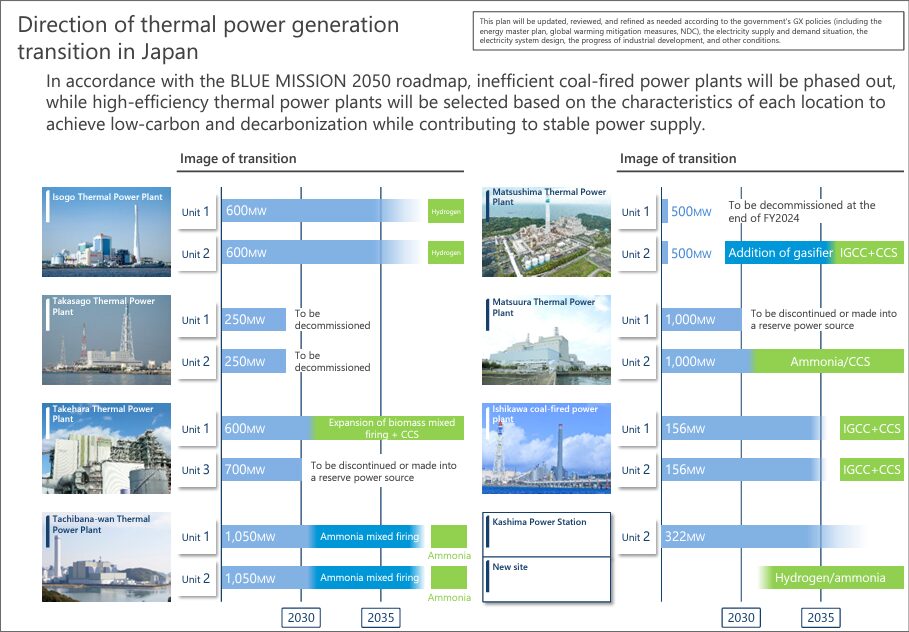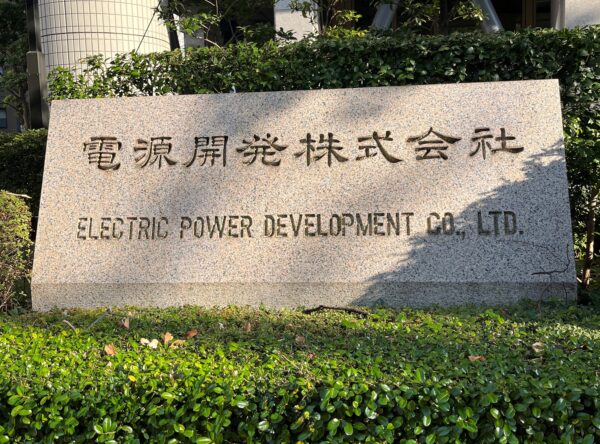On May 9, 2024, J-POWER, Japan’s second largest coal-fired thermal power plant operator in terms of installed capacity, announced the “J-POWER Medium-Term Management Plan FY2024-FY2026”. In the plan, J-POWER presented the direction of future thermal power transitions in Japan and listed the names of coal-fired power plants that it will be shutting down. However, all of them are aging and inefficient coal-fired power plants, and it is difficult to say that J-POWER has shown any indication that it is working to proactively develop a phase-out plan.

Point 1. Only three aging units are certain to be shut down
There are only three units announced to be shutting down by FY2030: Matsushima Thermal Power Station Unit 1 (began operation in 1981, planned to be decommissioned at the end of FY2024), and Takasago Power Station Units 1 and 2 (began operation in 1967 and 1969, respectively). Matsushima Unit 1 is not a new addition to the list, as J-POWER had previously confirmed in October 2023 that it would retire Unit 1 by the end of FY2024 when it announced its “Plans for Matsushima Thermal Power Plant”. Takasago Power Station is out of operation until June 4 on the database showing power plant activity (as of May 8), and its operation rate is expected to be low.
Both Takehara Power Station Unit 3 (began operation in 1983) and Matsuura Power Station Unit 1 (began operation in 1990) are both scheduled to be either decommissioned or made into reserve power sources, so their retirement has not been made definite. These two units are inefficient coal-fired power plants using technology with a high emission factor (supercritical, or SC) and have been in operation for more than 30 years. The decision to decommission these units should have been made in 2020, when the Ministry of Economy, Trade, and Industry announced its policy to “fade out” inefficient coal-fired power plants by FY2030.

Point 2. Is it possible to reduce emissions through so-called “transition”?
Under this plan, Isogo Power Station Units 1 and 2, Takehara Power Station Unit 1, Tachibana-wan J-POWER Power Station Units 1 and 2, Matsushima Power Station Unit 2, Ishikawa Power Station Units 1 and 2, and Kashima Power Station Unit 2, which is operated by joint venture company Kashima Power, will be subject to implementation of “emission reduction measures” such as hydrogen/ammonia co-firing, biomass co-firing, adding Integrated coal Gasification Combined Cycle (IGCC) facilities, and carbon capture and storage (CCS). As JBC has repeatedly pointed out, these measures have little effect on CO2 emission reductions, and this plan does not provide any detailed emission reductions.
With the exception of Matsushima Unit 2, which is currently under environmental impact assessment as part of the GENESIS Matsushima Project to add a gasification facility, all units are timed for 2030 or later, and these plans are not consistent with Japan’s commitment to “phase out existing unabated coal power generation in our energy systems during the first half of 2030s” as stated in the 2024 G7 leaders’ communiqué.
Point 3. What about all the other coal-fired power plants?
There are only 5 units (2,700 MW in total) set to be retired, or either retired or made into a reserve power source. This is less than 30% of J-POWER’s total installed capacity of coal-fired power in Japan (9,224 MW), meaning that even if all five units are treated according to plan, J-POWER will still continue generating electricity by burning coal beyond 2035. If coal-fired power plants are allowed to continue to operate after 2035, and are not subject to phase-out because of so-called “transition” measures that consider them as “abated”, it will be impossible to achieve net zero emissions by 2050.
CCS is also planned for Matsushima Unit 2, Matsuura Unit 2, Ishikawa Units 1 and 2, and Takehara Unit 1. However, the feasibility of CCS to capture and store the significant amounts of CO2 emitted from large-scale coal-fired power plants is as uncertain as the establishment of hydrogen/ammonia co-firing technology.
Power utilities, including J-POWER, must phase out existing coal-fired power plants on a timeline consistent with the 1.5°C target. It’s up to us, as consumers, to make sure that companies’ phase-out plans are steadily progressing in accordance with international agreements.

